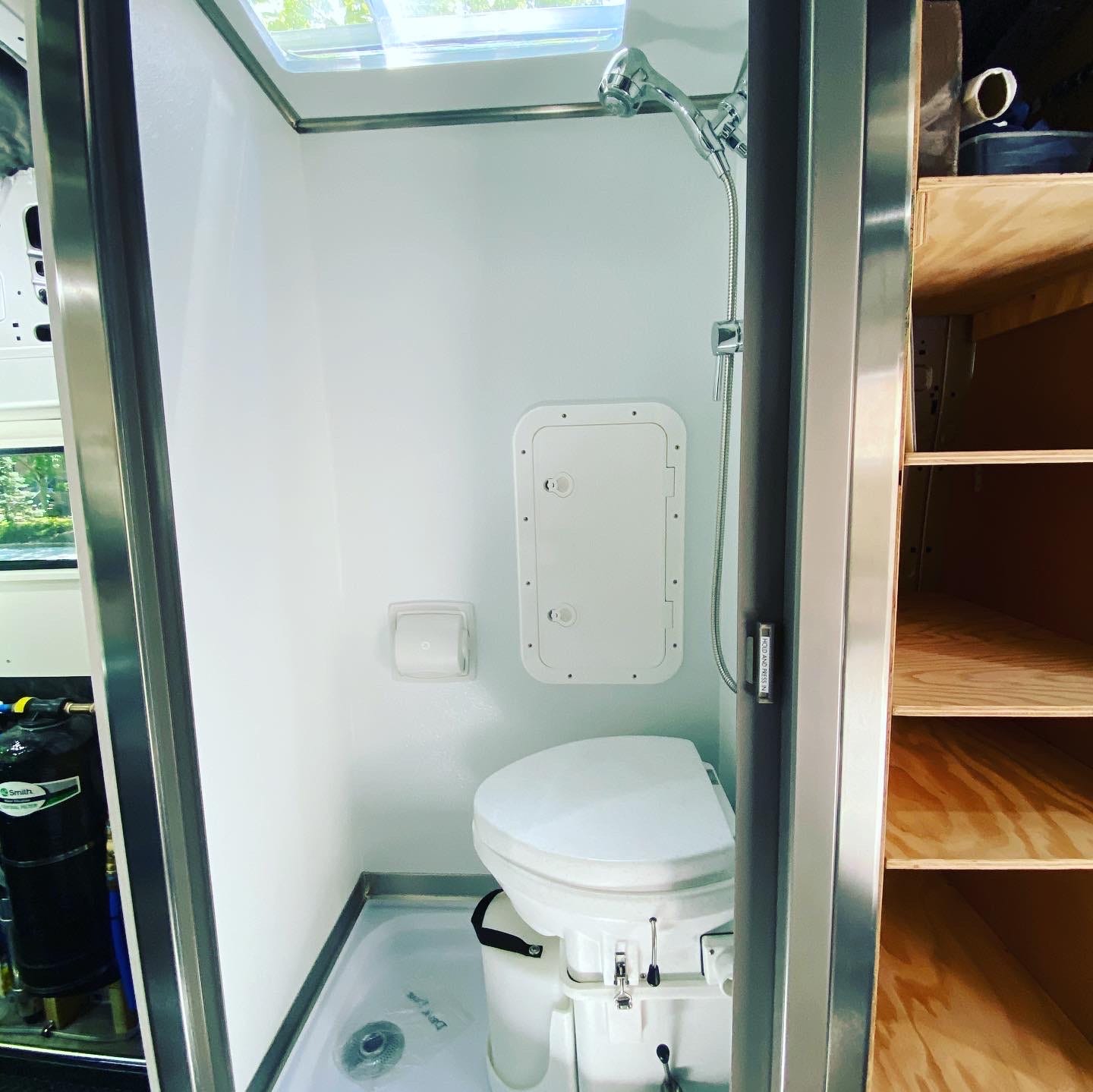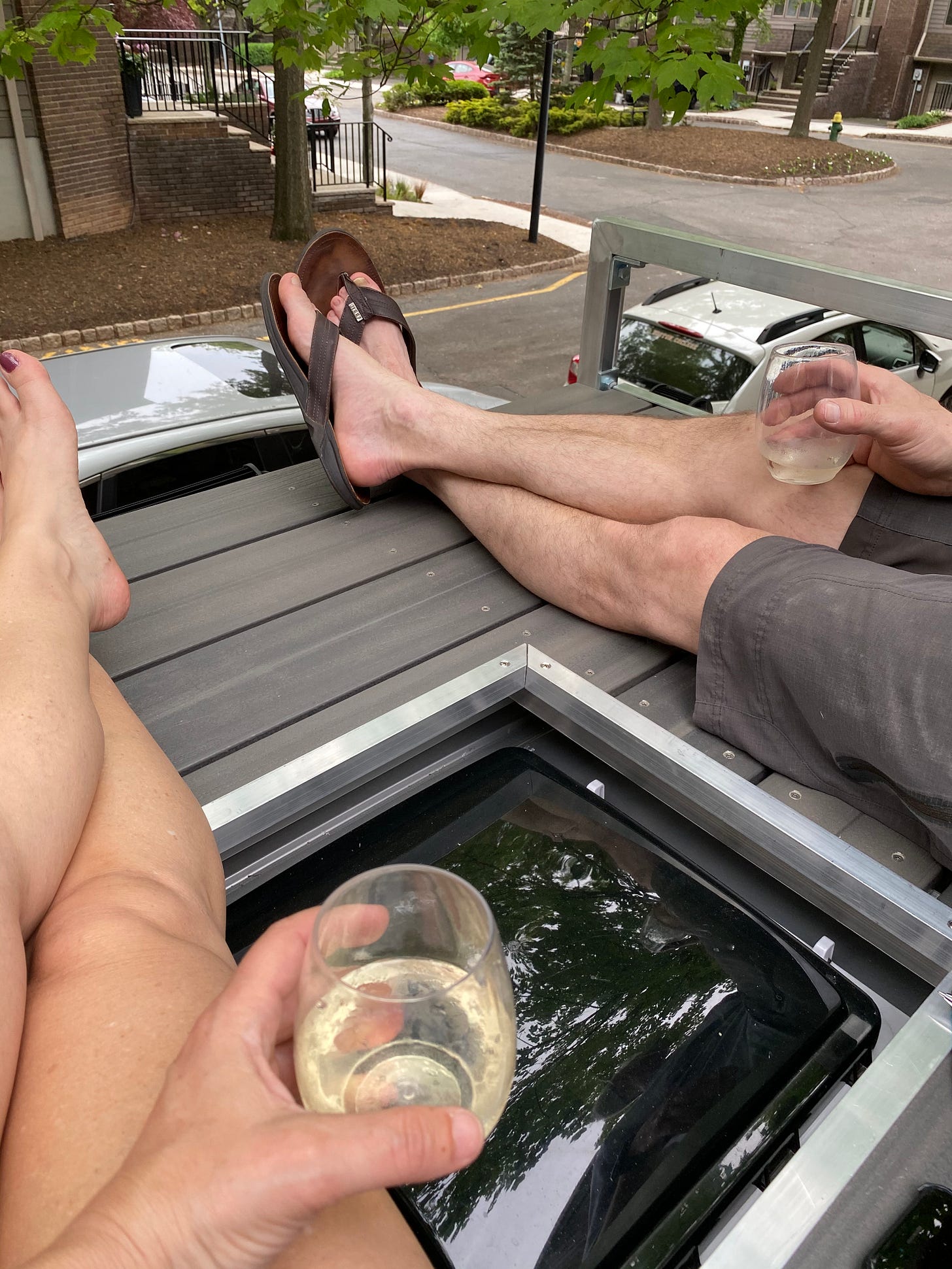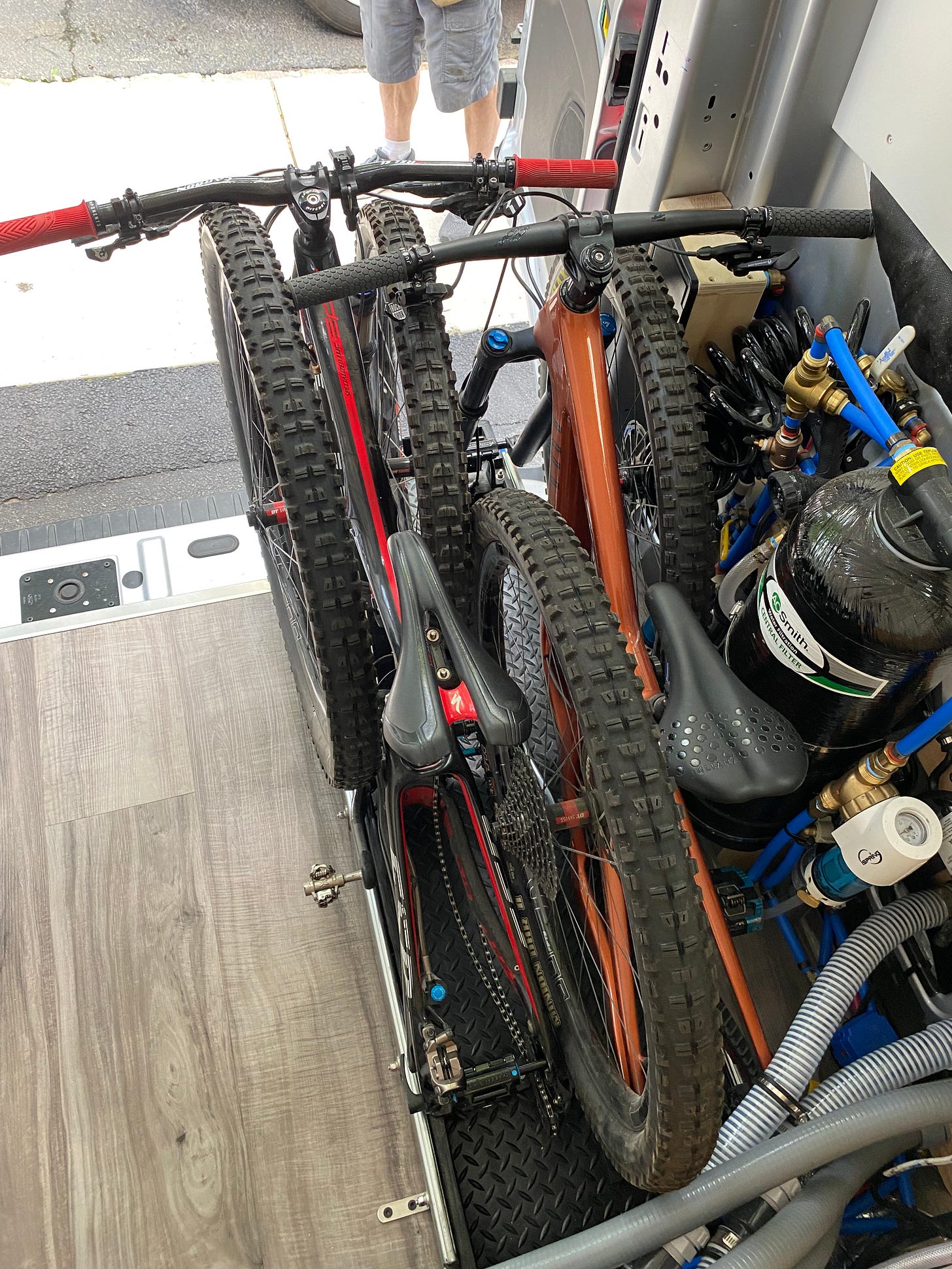The build, the basics
Journal Entry #3
August 6, 2021
We bought the van— a completely empty AWD cargo vehicle with no windows — so that we could customize it to meet our needs. To do so, we outlined the things we really wanted for living on the road. Here were our basic “need to” haves:
Ability to live ON grid (eg hook up at a campground) but equally capable of functioning OFF grid (eg in the middle of nowhere which is very much a part of our plan!) This meant figuring out power and water systems that could work without “shore water and power.” We opted to install a 500Ah lithium battery bank and a 3000w inverter. Batteries can be recharged via our dual alternators (an option we requested when we ordered our van) when the engine is running or from shore power. We have 12V and 120V capacity for our various appliances. We have monitors to manage energy, power and water levels.
A fully functioning (nice looking) kitchen with refrigerator, oven, range top, decent sink, and good work space as I love to cook (and I’m excited about the challenge of doing this on the road).
A toilet and an indoor shower. Sure, we can still use campgrounds, or friends homes, as available, but we are 53 and at this point wanted to have these amenities so that we don’t always have to seek them out. (I’ll admit to getting up at least once in the middle of the night to address “necessities”. Wandering outside of the van at 2 am was not an option.) Our plumbing system is fairly complex. We have a recirculating shower with hot water generated our engine coolant. The water for the shower runs through a filtration system with 5 filters (2 UV filters) so that it can be reutilized. Our potable (that is, drinking, non shower) water has a separate tank for clean water and a gray tank for used water. We can swap to shore water and fill up both systems as needed. We have an instant hot water heater for the kitchen sink (potable water). Toilet is a composting toilet. (Everyone has questions about the toilet! Ask away and I will answer!)
A bed. Not a foldout/drop down, Murphy half couch thing. A decent (if small; double/full) 8 inch mattress. It helps that we are both small in stature (5‘1” and 5’7”) which made an east-west bed configuration (across the van) possible.
A “Garage.” Space under our (platform) bed for two mountain bikes, camp chairs, an outdoor mat to expand our living space, a portable outdoor grill, an inflatable kayak and a telescoping ladder (to reach the roof deck and other storage) and van tools, and access to plumbing and electrics/battery.
A sitting/dining area and ample interior storage for clothing, food and other stuff.
Good lighting, both indoor, and outdoor (for navigating camping locations if dark) and good windows, skylight for natural light.
Interior heating that we can use to warm the van even if the engine is not running. We opted for a Webasto heater that sips gasoline from our fuel tank.
Cooling and air circulation. We installed two powerful Maxxair fans that can circulate air and cool the van. Keep in mind we will be chasing temperate weather between September and next July. Neither of us love really hot weather. We’d take colder over warmer and enjoy sleeping cold. If it’s too warm where we are, we will drive “up” to higher altitudes. We will avoid snow/ice as much as we can but if it is chilly at night that’s when the Webasto heater is handy.
Safety and drive-ability. Secure locks beyond the Ford standard. A secure area for any valuables. Inflatable air springs that can be deployed for rougher road as well as additional sway bars for vehicle balance.
Internet. We have signal booster so that we can have a better chance at signal. The Van has it’s own hot spot (ATT) and we will carry our phones (Verizon). But the fact remains that there will be time when we will be in places that have NO signal to boost.
Privacy and some decent insect protection. We invested in some good window covers that are tailored specifically our van (with reflection and insulation for heat and cold and will also help with noise) as well as custom zip screens that we can use for our sliding door and back doors as needed.
Roof Deck and “He” and “She” sheds (Thule cargo tops). Actually these weren’t need to haves. More nice to haves. But we decided to go for it.
“Big” things we passed on:
NO TV. Lots of people have asked us where we planned to hang a TV. Though we may tap into our computer screen from time to time (we will bring a laptop), our goal is that the places we go and people we see and meet will be the entertainment.
NO A/C. We have the van A/C that we can run temporarily to cool things down but no additional unit. If we change our minds, we protected for installation (we can remove one of our fans and replace with a unit).
NO Laundry. We invested in something called a “Scrubba” (clothes washing bag) and we have a generous sink. This is where campgrounds, friends, and the occasional airbnb will have to suffice.
Our “need to haves” needed to fit into 110 square feet of living space. And for a start, this living space has NO straight walls to work with. In addition, this is living space that will be subjected to motion on the road — essentially mini earthquakes all the time. The project was like building a custom tiny house boat. We are dealing with no right angles, we must be creative with very little space, and we make all the systems able to withstand constant motion, and yet still build for some comfort.
It’s a tall order. And we are doing this on our own. We are closing in on completion, with just about three weeks left to get most of the bigger stuff done. But the pressure is on and we are working on the build and preparation full time at the moment. It’s hard to believe that 100+ square feet — smaller than many people’s home bathrooms — will include ALL of these must haves. It’s also hard to believe that just 100+ square feet will have taken us nine solid months to build out.
Credit goes almost entirely to Tom for the core power/electric/plumbing systems design and the sheer will and mechanical and woodworking skills to build nearly everything by hand as well as flex and problem solve along the way. I am in awe. Right now Tom is sanding and sealing our butcher block kitchen counter top, having finished hooking up the electric and kitchen plumbing. Meanwhile the basement has become my workshop the past few weeks for all of the puttying, priming and painting of cabinets and cabinet door fronts which is no small feat. Still to do is the welding of our platform bed frame and installing and hooking up the gray tank under the van. And installing the cabinets, and the backsplash, and doing all of the final touch up and trim work, and, and, and… let’s just say that it will be down to the wire. Movers come for our last items that will go to storage on August 30th. (Did I mention I was just in Florida helping E move into and settle into her new apartment and I have to get H off to college in two weeks as well? Crazy times!)
We will likely make a “video” walk-through of “Coddiewomple” (our van’s given name, or “Womp” for short) and and post it when “she’s” all done. Why this name? We think it’s fitting:
An English slang word, the definition of coddiwomple (v) is: “to travel in a purposeful manner towards a vague destination”.
Here are just a few select pictures of some of the effort over the past eight months. And I’ll post more here and on Instagram @We_two_van_dreamers and FaceBook too as we complete the work. The truth is the pictures and videos of the '“finished product” don’t do the build justice at all. The thought, the effort, the problem solving and the teamwork in this “labor of love” can’t really be captured in pictures.

If you have any questions about the build itself (or anything, really) we are happy to answer them. We can share specifics about the process, design, products used etc. We designed and built the van with our specific wish list in mind and tried to anticipate the challenges that we might encounter. Of course, the real test of our build will be played out on the road.













Hi Tom and Amie! I'm thoroughly enjoying your journal - but a bit behind on your posts. I'm curious for more details on that recirculating shower (as well as the composting toilet)! You say in the post that you can top off the recirc tank - do you also need to flush it out occasionally? How big is the tank? And - if you're in "recirc" mode - does that limit the length of the shower (ie...can the filtration system keep up with the drain?). Lastly - can you make alignment changes from inside the van, or does Tom need to crawl underneath to change the valve settings? Bear in mind that my RVing experience was four decades ago - when my family owned a twenty-two foot Class C (1977 Coachmen Leprechaun)! I have lots of fond memories from our various cross-country journeys, and am excited and happy for you both!
Fascinating. I'm a bit envious! Do you power the electric cook top from batteries!? Or only when on "shore power"?